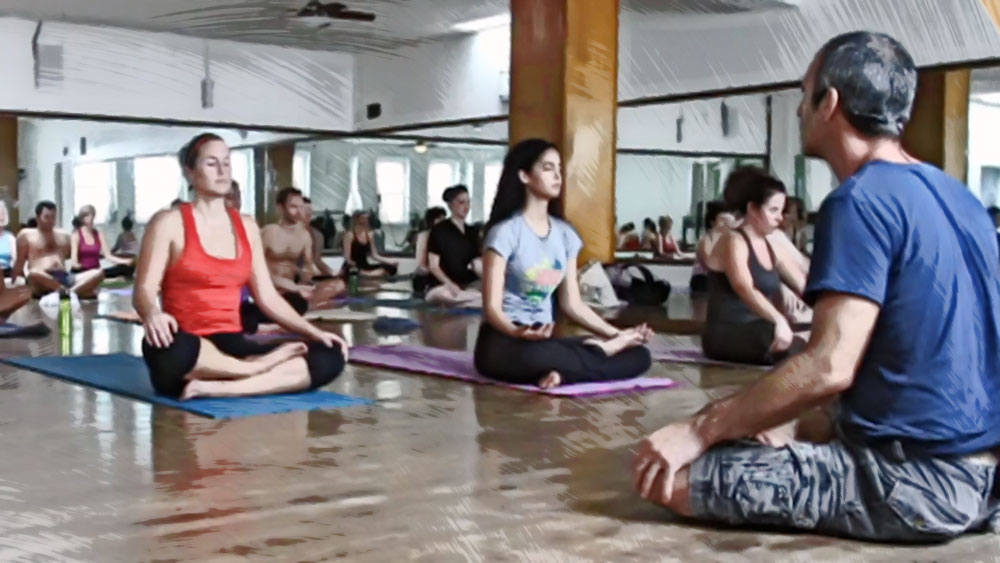Am I Meditating the Right Way? (Poses, Techniques & Exercises for Beginners)

As a beginner to yoga and meditation, I often asked myself, "Am I meditating the right way?"
I pondered more questions such as,
- Are yoga and meditation the same thing?
- How should I place my hands when I am meditating and does this really matter?
- Should I meditate before or after my physical asana practice?
The more time I spent on my mat, whether it was to sit quietly with my eyes closed and watch my breath or to move through physical asana practice, it became clear to me that personal experience coupled with the process of tuning into what my emotional and physical body needed the most that day, would serve as my ultimate guide. Nonetheless, as someone new to the practice, I think it is helpful to be armed with some basic information to sift through the layers of content provided on the Internet and to help formulate questions to ask of long-time practitioners and respected teachers as you travel along your path.
So...to get you started, here are some common questions asked by beginners:
Are yoga and meditation the same thing?
In the beginning, my yoga practice was defined purely by physical asana. My perspective was that the physical practice was distinct from my sitting meditation. Now, the two have merged into one, and there is no distinction in terms of the final product. In fact, on a fundamental level, meditation is a process whereby one is “mindful” of an object, such as the breath, to help anchor the student in present-moment experience, ideally without judgment, criticism, or evaluation. This practice has become far more important and beneficial in my life relative to the physical asana, which is now a precursor to my sitting practice. Personally, without meditation, there is no practice.
What is a yoga meditation position?
Outlined below are some common yoga meditation poses to experiment with when deciding which position resonates for you. It is most likely the structure of these poses that will best support the body for yoga and meditation. Again, this is general information and should not preclude you from experimenting with other poses.
Easy pose: This is one of the most approachable poses, especially for beginners, and lends itself nicely to supporting the body during meditation. Generally, this pose is done by sitting with the legs crossed, feet resting on the floor, one foot in front of the other. The pose can also be done with a prop, such as a bolster or a block, placed under the sit bones to elevate the hips and alleviate exacerbation of pain/pressure in the knees.
Relaxed lotus: Another approachable pose, especially if you have tight hips or knees. Sit with legs crossed at the shins, and with feet resting underneath opposite knees.
Half lotus: A variation on full lotus pose. This is similar to full lotus, but rather than having both feet on top of opposite thighs, just one foot is placed on top of the opposite though, with the other foot resting under opposite knee.
Full lotus: Most challenging to hold, sit with legs crossed as shins and feet placed on top of opposite thighs.
What is an optimal yoga meditation position?
While there is no “optimal” position to speak of, a few things you should be mindful of when practicing a seated meditation, including the position of your spine and shoulders, and the placement of your hands and eyes. You will want to sit upright with the spine reasonably erect, shoulders relaxed down away from your ears, and eyes either open or closed. If open, rest your gaze on a neutral object to minimize distraction. Hand placement can also vary according to your preference. Yoga philosophy posits that hands placed in a mudra (Sanskrit word meaning to “seal in” or to close your practice) position during meditation is meaningful. For example, connecting the thumb with the index finger, with palms facing up, suggests reception of energy and willingness to be open and spacious. While the same mudra with palms facing down suggests grounding energy, connecting the body with the earth. Then there is the placement of hands in the lap, with one hand resting on top of the other hand. This is known as the “meditation seal” and is associated with synergy between the right and left hemispheres.
What are meditation techniques? Am I doing this the right way?
There are a variety of yoga meditation techniques that can be used to support one’s practice, including attentional focus, open monitoring, and Transcendental Meditation (TM).
With attentional focus, a neutral object is used to steady the mind and cultivate focus and present-moment awareness is to focus on the breath during a meditation or yoga practice. The breath can be accessed at any time and from anywhere, whether we are driving in our car or standing on our yoga mat. The other amazing aspect of breath is that we can use it to anchor us in our bodies. For example, when we associate counting with the breath, drawing out the inhalation and exhalation to a 4 or 5 second count, that process in and of itself is useful to cultivate and maintain focus and to stay in the present moment experience.
Considered a little more “advanced”, open monitoring asks the student to notice whatever is arising in that moment without reacting. The student is asked to be an “observer” of whatever thoughts, feelings, emotions arise without criticism or evaluation, to sit with that experience, and then to come back to a focal point such as the breath, the sound of a person’s voice, or the subtle vibration of background noise.
Transcendental meditation (TM) is another technique popularized by Maharishi. This Hindu technique provides students with a “mantra” or sacred word that is chanted internally for a 20-minute period, both in the morning and in the evening. To learn this technique, one needs to complete a course offered by a certified teacher trained in TM. TM is an evidence-based approach that has shown significant benefits for people experiencing traumatic stress, depression, and anxiety.
Ultimately, while it may seem daunting to begin a yoga meditation practice, beginners and long-time students alike can find refuge in the following:
1) Set feasible goals. For example, you might start by doing a short practice (physical asana and sitting meditation) 3 days a week. Do this for one month, then gradually increase the duration and frequency of your practice. The time of day is also important to consider as this can affect your ability to accomplish the previous step. If you know that your morning is unaffected by kids, work, etc., and you have more energy in the morning relative to the evening, then morning would be the optimal time for you to practice.
2) Location. Think about whether practicing in a studio or at home is optimal given your lifestyle.
3) Technique. This addresses the sitting part of your practice. Use a technique that is approachable for you. Students will often want to start with something like paying attention to the breath, using the breath as a focal point to return to when the mind becomes distracted by thoughts, emotions, feelings. Another technique that is extremely useful for those wanting to keep their eyes open is to gaze at a neutral object like a tree or piece of furniture.
4) Posture(s). For your sitting meditation, experiment with various posture(s) to determine what works best for you. This can also vary based on what you are looking for/focusing on in your practice. For example, you may want to focus on intention setting, cultivating loving-kindness, or self-forgiveness.
